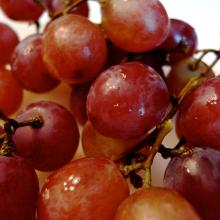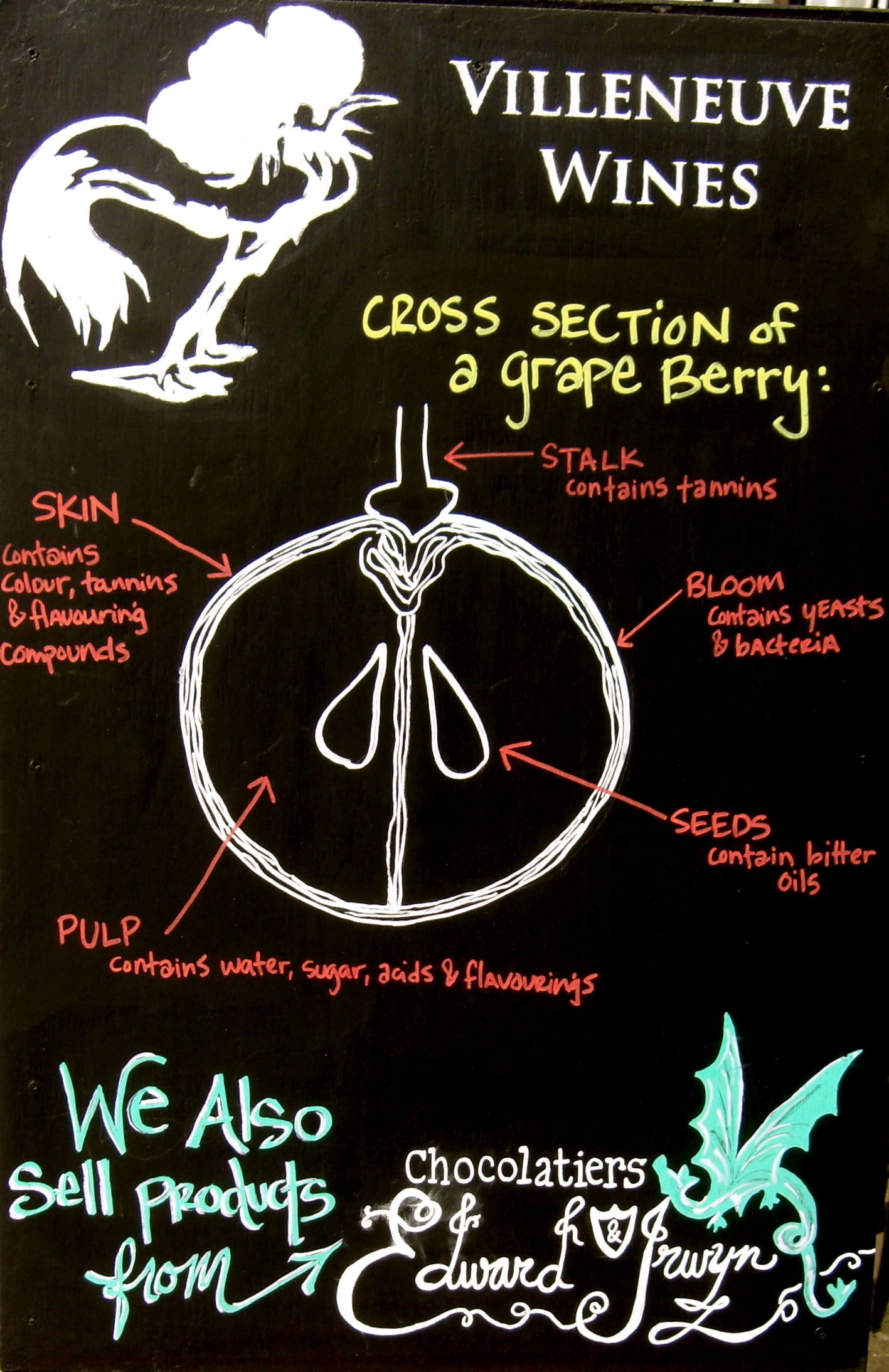
Did you know that vines produce a kind of berry?
Spurtle didn't, until the arrival of a new design on the A-board outside Villeneuve Wines on Broughton Street (see below).
We applaud theis shop's intermittent forays into Education, but on this occasion were left thirsting for more.
Somebody using the name 'Rootbender' provided exhaustive coverage on Yahoo Answers four years ago. We have decided to share his insights with a grapeful nation.
Botanically speaking, fruit is classified as being either DRY or FLESHY.
FLESHY FRUIT can be further subdivided into those formed from a single flower and those formed from a group of flowers.
The following are FLESHY FRUITS that form from a single flower:
A Berry is a single fleshy fruit without a stone, usually containing a number of seeds. (i.e. blueberry)
A Drupe is a single fleshy fruit with a hard stone which contains the single seed. (i.e. peach)
A Pome is a fleshy fruit with a thin skin, not formed from the ovary but from another part of the floral structure. (i.e. apple)
A Hesperidium is a berry with a tough, aromatic rind. (i.e. orange)
A Hip is a fleshy fruit containing achenes. (i.e. rose)
A Pepo is a fleshy fruit with a leathery skin, formed from an inferior ovary. (i.e. cucumber).
A Pseudocarp is a false fruit, because it does not contain the seeds. The seeds are achenes, on the outside of a fleshy fruit. (i.e. strawberry).
The following are FLESHY FRUITS that form from a group of flowers.
A Sorosis is a collective fruit, formed of a number of separate flowers firmly coherent into a fleshy or pulpy mass with the floral axis upon which they are situated.(i.e. raspberry)
A Syconus is a collective fruit, formed of an enlarged and more or less succulent receptacle, which bears a number of separate flowers. (i.e. fig).
DRY FRUITS can be further subdivided into those that Dehisce (burst open at maturity) and those that do not.
The following are examples of DRY, DEHISCENT FRUITS:
A Follicle is a dry dehiscent fruit which splits on one side only and may contain one or many seeds. (i.e. columbine)
A Legume is a dry dehiscent pod that splits on two sides. (i.e. pea)
A Lomentum is a dry dehiscent fruit, a legume constricted between the seeds. (i.e. Sophora)
A Silique is a dry dehiscent fruit. It is long and thin, splits down the two long sides, and has a papery membrane called the septum, located between the two halves. (i.e. cabbage).
A Valvate Capsule is a dry dehiscent fruit in which the tips of the seed capsule split. (i.e. primrose).
A Porose Capsule is a dry dehiscent fruit, opening with pores or holes around the top. (i.e. poppy).
A Loculicidal Capsule is a dry dehiscent fruit, splitting along the locule (midrib of each ovary). (i.e. iris)
A Circumscissile Capsule is a dry dehiscent fruit, opening by splitting through the center of the fruit, so that the top of the capsule lifts off like a lid. (i.e. pimpernel).
A Septicidal Capsule splits along the septa (joints of the ovary). (i.e. foxglove).
The following are examples of DRY, INDEHISCENT FRUITS:
An Achene is a single-seeded dry indehiscent fruit in which the seedcoat is not part of the fruit coat. (i.e. sunflower).
A Cypsela is a single-seeded dry indehiscent fruit that develops from a one part inferior ovary. (i.e. dandelion).
A Nut is a large single hardened achene, (i.e. chestnut).
A Caryopsis is a simple dry indehiscent fruit, like an achene, but with the seedcoat fused with the fruit coat. (i.e. corn).
A Samara is an independent dry indehiscent fruit which has part of the fruit wall (the pericarp) extended to form a wing. (i.e. maple).[Image top-right by Editor at Large, Creative Commons. Image bottom-right by Fir0002/Flagstaffotos.]